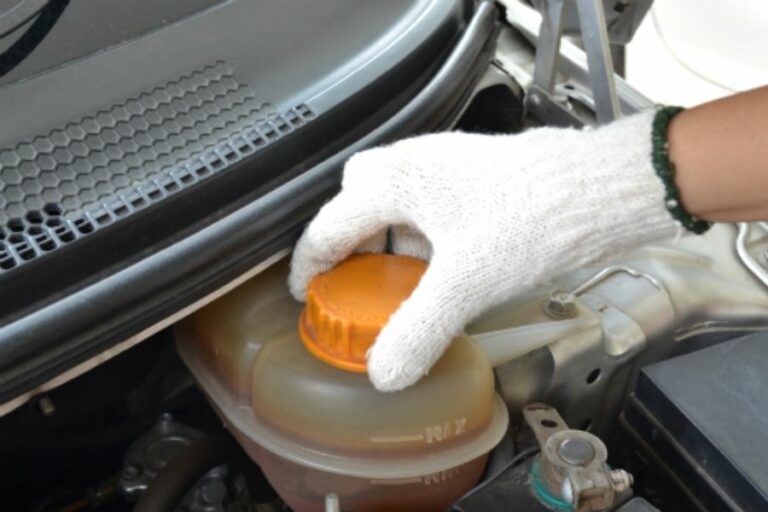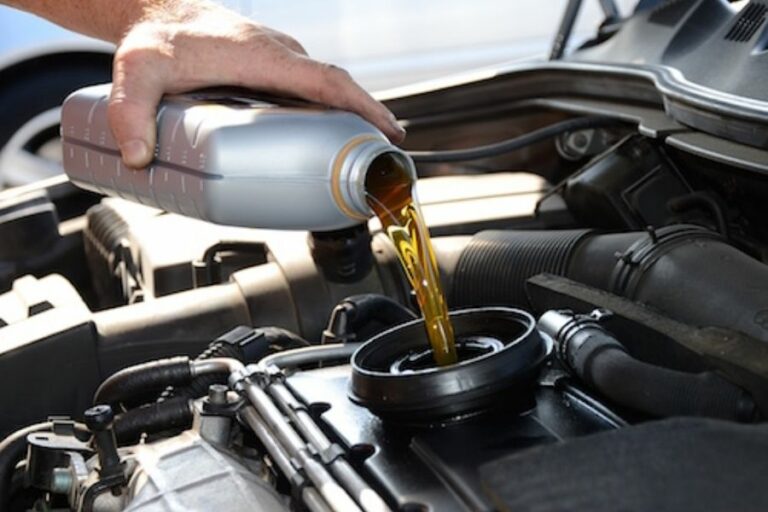Can You Mix Power Steering Fluid? Know Everything About It
While refilling or topping up the power steering fluids, it is quite common to wonder if you Can mix Two Different Types Of Fluids? Can You Mix Red And Green Power Steering Fluids? Or Can you Mix Old And New Fluids?
The short answer is, as a general rule of maintenance, you must never mix. However, there are some exceptions. To know more about this phenomenon and get a clear idea of what you should do, go through this article till the very end.
What Are Power Steering Fluids, and How Do They Work?

If you have driven an old and rusty car from the 90s, you might notice how difficult and rough it was to steer the vehicle.
It was because the steering wheel was connected to the shaft mechanically through metal rods and gears.
Therefore, over time, the steering system used to get rusty and corroded. Hence, it becomes less smooth and tighter rotating the wheels.
To overcome this, power steering technology came into play. Let’s take a peek at how power steering technology actually works.
Power Steering Fluid Working Mechanism

Power steering fluid is one type of hydraulic fluid used in power steering systems. It is utilized to transfer power from the steering wheel to the steering mechanism of your vehicle.
This technology uses the principle of hydraulic pressure to assist the driver in rotating the steering wheel and making it easier to maneuver the vehicle. The complete system consists of a pump, different hoses, a fluid container, and a steering gear.
When the driver turns the steering wheel, the pump, usually driven by a belt attached to the engine, puts pressure on the power steering fluid. This pressure is transferred through the hoses to the steering gear.
Now, you’ll see a piston that is connected to the steering mechanism. When the pressurized fluid enters the steering gear, it pushes against the piston, providing a hydraulic assist to the steering mechanism. As a result, it becomes easier for you to turn the car wheels smoothly.
Read Also: Is Power Steering Fluid The Same As Brake Fluid
Why Are Power Steering Fluids Important?
Most newer models of vehicles, starting from basic sedans to giant trucks, are using power steering nowadays. Thus, it is very essential to keep track of the efficient use of the power steering fluids.
Smooth Steering Performance
Power steering systems use hydraulic pressure to assist drivers in turning the steering wheel. As a result, it becomes convenient and smoother to maneuver their vehicles.
Protects Different Components
Power steering fluids also work as a lubricant in the system. It minimizes wear and tear on the steering components. Without proper lubrication, the steering gear, pump, and hoses in your car can become damaged due to corrosion resulting in costly repairs.
Eliminates Heat
Power steering systems generate a significant amount of heat, which can cause damage to the components, especially when you are commuting down the city. But, power steering fluids help dissipate this heat, lowering the chances of damage to the system.
Read Also: Can You Drive a Car Without Power Steering Fluid
How Often Should You Change Power Steering Fluid?
It depends upon your driving style, vehicle specification, and other factors that matter in the schedule to change the power steering fluid. In general, you can change the fluid every 50000 to 60000 miles or after 2-4 years.
Can You Mix Power Steering Fluids?
Now we are going to discuss that can you mix red and clear power steering fluid or can you mix red and green power steering fluid. So stay with us to know about it!
Can You Mix Two Different Types Of Fluids?
Now, in the marketplace, you’ll get three types of widely used power steering fluids. These are mineral, synthetic, and semisynthetic power steering fluids.
In such circumstances, you are forbidden from mixing the fluids. Each of these fluids has different chemical composition, specifications, applicability, and efficiency.
Moreover, most vehicles specify in their manual what type of power steering fluid should be used. Thus, mixing two different types of fluid would decrease the effectiveness of the fluid and your power steering would fail in performance.
Read Also: BMW Power Steering Fluid Type – You Need Know Everything
Can you Mix Old And New Fluids?
In the next scenario, we shall look into mixing old and new fluids. Sometimes, due to leakage or other physical damage, the amount of power steering fluid in the reservoir decreases from the optimum level.
For such cases, you might wonder if it is okay to mix some new fluid to top up the old fluid up to the nominal level.
According to the service manual and the expert’s recommendation, you cannot mix old and new fluids, even if they belong to the same brand.
But, considering the fluid you already have in the reservoir is recently topped and has not been used much, you can mix them.
This should be done only in special cases such as if you need to take your car to a garage or need emergency travelling.
However, once you are done, you must flush the existing power steering fluid and top up the reservoir with fresh and compatible fluid.
Mixing old and new fluids can be troublesome as the viscosities and other physical parameters of the fluids change over time.
Can You Mix Red And Green Power Steering Fluids?
The colors of power steering fluids are only due to additives. It is a symptom that the power steering fluids come from different brands.
Even though the fluids from the different brands have the same grade and are rated equally, you are not supposed to mix them.
Mixing fluids from different brands can reduce the effectiveness of both fluids. As a result, it won’t create sufficient hydraulic pressure as it was supposed to create.
Hence, your driving maneuverability would get hampered, which is quite dangerous if you drive at a high speed.
Read Also: How Much Power Steering Fluid Does A Car Hold?
How To Drain And Refill Power Steering Fluid?
After driving for a certain distance the power steering fluids including other fluids such as brake fluid, transmission fluid, etc requires changing. The method is pretty straightforward, and you need not visit a garage and spend money on this.
Locate And Remove Old Fluid
The reservoir is usually located near the power steering pump. You can check for the labeling or marks. Depending on your vehicle, you may need to use a hand pump or a sump pump.
Some vehicles may also have a drain plug on the power steering system that can be removed to drain the old fluid.
Flush System And Refill New Fluid
Flush the power steering system to ensure all old fluid is removed from the system. You can do this by adding new fluid to the reservoir, starting the engine, and turning the steering wheel back and forth a few times. Repeat this process until the fluid coming out of the system is clean.
Once the system is flushed, pour a sufficient amount of preowned fluid into the reservoir. Remove all air bubbles if there are any.
Turn on the engine and let it run for a few minutes while checking the fluid level in the reservoir.
Top up more fluid as needed to bring it to the optimum level. Lastly, rotate the steering wheel back and forth a few times to check the pressure is nominal and smoother to conclude your power steering system is functioning properly.
Read Also: Toyota Power Steering Fluid Price, Change interval, Type
What Causes Power Steering Problems?
There are a number of things that can cause power steering problems, including:
- Low power steering fluid: This is the most common cause of power steering problems. Power steering fluid is a hydraulic fluid that helps to amplify the driver’s steering input. If the fluid level is low, the power steering system will not be able to operate properly.
- Power steering fluid leak: If there is a leak in the power steering system, it can cause the fluid level to drop and lead to steering problems. Leaks can occur at the power steering pump, hoses, or steering rack.
- Worn power steering pump: The power steering pump is responsible for circulating the power steering fluid throughout the system. If the pump is worn out, it may not be able to generate enough pressure to properly assist the driver’s steering input.
- Worn power steering belt: The power steering belt is responsible for driving the power steering pump. If the belt is worn out, it may slip or break, which can cause the power steering pump to fail.
- Worn power steering rack: The power steering rack is the component that converts the hydraulic pressure from the power steering pump into mechanical motion to turn the front wheels. If the rack is worn out, it can cause steering problems such as looseness, vibration, and difficulty turning.
- Air in the power steering system: If air gets into the power steering system, it can cause the steering to feel spongy or unresponsive. Air can get into the system through a leak or when the power steering fluid is changed.
- Electrical problems: In electric power steering systems, problems can arise from a failure in the electric motor, sensors, or electronic control unit (ECU).
FAQs.
By now, hopefully you have got the answer: can you mix power steering fluid. Here are some of the FAQs that you might want to know.
Are power steering fluid and transmission fluids the same?
Although both fluids are known as hydraulic fluids, they are not the same. The chemical composition and additives in these fluids are very different, resulting in them not being interchangeable.
What might happen if you use the wrong power steering fluid?
Using the wrong fluid in the power steering system can cause trouble to your driving maneuverability. Lack of steering assistance, hard steering, and unbalanced steering might happen using incorrect power steering fluid.
Final Talk
Now I think you get a brief idea about this question that can you mix power steering fluid because here I provide the complete information about it.
So if you have any other querry about the vehicle then you visit our site because here we provide the complete guidence about it.






